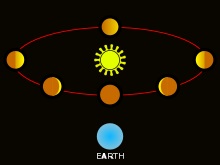 |
| Galileo's discovery
that Venus showed phases (although remaining
near the Sun in Earth's sky) proved that it
orbits the Sun and not Earth. |
Exploration
The first robotic space probe mission to Venus, and the
first to any planet, began with the Soviet Venera
program in 1961. The United States' exploration of Venus
had its first success with the Mariner 2 mission on 14
December 1962, becoming the world's first successful
interplanetary mission, passing 34,833 km (21,644 mi)
above the surface of Venus, and gathering data on the
planet's atmosphere.
On 18 October 1967, the Soviet Venera 4 successfully
entered the atmosphere and deployed science experiments.
Venera 4 showed the surface temperature was hotter than
Mariner 2 had calculated, at almost 500 °C (932 °F),
determined that the atmosphere is 95% carbon dioxide
(CO2), and discovered that Venus's atmosphere was
considerably denser than Venera 4's designers had
anticipated. The joint Venera 4–Mariner 5 data were
analysed by a combined Soviet–American science team over
the following year, in an early example of space
cooperation.
Venera 7, the first space probe to land on Venus, was
destroyed by the hostile conditions on Venus after only
23 minutes. In 1974, Mariner 10 swung by Venus on its
way to Mercury and took ultraviolet photographs of the
clouds, revealing the extraordinarily high wind speeds
in the Venusian atmosphere.
In 1975, the Soviet Venera 9 and 10 landers transmitted
the first images from the surface of Venus, which were
in black and white. In 1982 the first colour images of
the surface were obtained with the Soviet Venera 13 and
14 landers.
NASA obtained additional data in 1978 with the Pioneer
Venus project that consisted of two separate missions:
Pioneer Venus Orbiter and Pioneer Venus Multiprobe. The
successful Soviet Venera program came to a close in
October 1983, when Venera 15 and 16 were placed in orbit
to conduct detailed mapping of 25% of Venus's terrain.
Several other Venus flybys took place in the 1980s and
1990s that increased the understanding of Venus,
including Vega 1 (1985), Vega 2 (1985), Galileo (1990),
Magellan (1994), Cassini–Huygens (1998), and MESSENGER
(2006).
Then, Venus Express by the European Space Agency (ESA)
entered orbit around Venus in April 2006. Equipped with
seven scientific instruments, Venus Express provided
unprecedented long-term observation of Venus's
atmosphere. ESA concluded that mission in December 2014.
As of 2016, Japan's Akatsuki is in a highly elliptical
orbit around Venus since 7 December 2015, and there are
several probing proposals under study by Roscosmos,
NASA, and India's ISRO.
In 2016, the NASA Innovative Advanced Concepts program
studied a rover, the Automaton Rover for Extreme
Environments, designed to survive for an extended time
in Venus' environmental conditions. It would be
controlled by a mechanical computer and driven by wind
power. |